Galls or cecidia are a kind of swelling growth on the external tissues of plants. Plant galls are abnormal outgrowths of plant tissues, similar to benign tumors or warts in animals. They can be caused by various parasites, from viruses, fungi and bacteria, to other plants, insects and mites. Plant galls are often highly organized structures so that the cause of the gall can often be determined without the actual agent being identified. This applies particularly to insect and mite plant galls. The study of plant galls is known as cecidology.

Diplolepis is a genus of approximately fifty species of gall-inducing wasps in the family Diplolepididae. The larvae induce galls on wild roses (Rosa), and rarely on domestic roses.
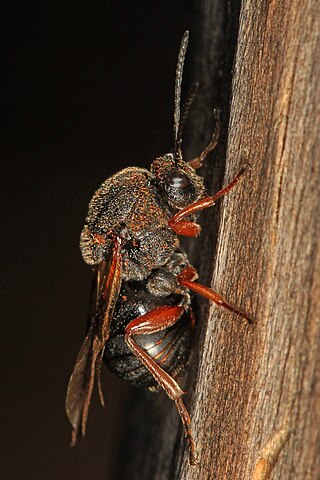
Gall wasps, also traditionally calledgallflies, are hymenopterans of the family Cynipidae in the wasp superfamily Cynipoidea. Their common name comes from the galls they induce on plants for larval development. About 1,300 species of this generally very small creature are known worldwide, with about 360 species of 36 different genera in Europe and some 800 species in North America.

Diplolepis rosae is a gall wasp which causes a gall known as the rose bedeguar gall, bedeguar gall wasp, Robin's pincushion, mossy rose gall, or simply moss gall. The gall develops as a chemically induced distortion of an unopened leaf axillary or terminal bud, mostly on field rose or dog rose shrubs. The female wasp lays up to 60 eggs within each leaf bud using her ovipositor. The grubs develop within the gall, and the wasps emerge in spring; the wasp is parthenogenetic with fewer than one percent being males.

Cynipinae is a subfamily of gall wasps (Cynipidae). Many of the approximately 1,500 described species cause galls on oaks, but some induce galls on other plant species or are inquilines of the gall-inducing species. Species occur on all continents except Antarctica, with most found in the temperate regions of the northern hemisphere. All extant cynipid species are within Cynipinae since the only other recognized subfamily is Hodiernocynipinae which is based on the fossil genus Hodiernocynips.

Andricus quercuscalifornicus, or the California gall wasp, is a small wasp species that induces oak apple galls on white oaks, primarily the valley oak but also other species such as Quercus berberidifolia. The California gall wasp is considered an ecosystem engineer, capable of manipulating the growth of galls for their own development. It is found from Washington, Oregon, and California to northern regions of Mexico. Often multiple wasps in different life stages occupy the same gall. The induced galls help establish complex insect communities, promoting the diversification in niche differentiation. Furthermore, the adaptive value of these galls could be attributed their ecological benefits such as nutrition, provision of microenvironment, and enemy avoidance.

Diplolepis mayri is a gall inducing insect causing galls on wild roses in the Western Palaearctic. Diploleis mayri is less frequent on rose shrubs than D. rosae.
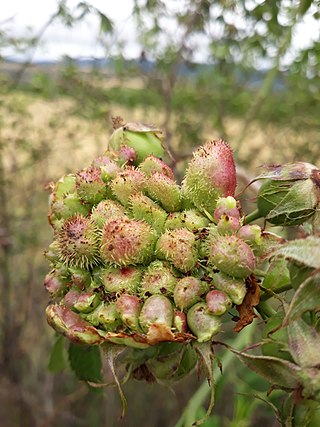
Diplolepis fructuum is a hymenopteran gall wasp which causes a galls on wild roses. The species is closely related to D. rosae and D. mayri but it produces its galls in the seeds of wild roses thus damaging its hips. The species is distributed mainly in the Northern regions of the Middle East, the Caucasus region and Northern shores of the Black Sea.

Diplolepis polita, known generally as the spiny leaf gall wasp, is a species of gall wasp in the family Cynipidae. It was first described by William Harris Ashmead in 1890.

Diplolepis ignota is a species of gall wasp (Cynipidae). Galls in which the larvae live and feed are formed on the leaves of several species of wild rose (Rosa). Individual galls are single-chambered and spherical, but multiple galls can coalesce into irregularly rounded galls.
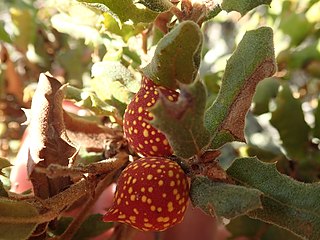
Burnettweldia is a genus of oak gall wasps in the Nearctic.

Burnettweldia plumbella, also known as the beaked twig gall wasp, is a species of gall wasp. Previously in the genus Disholcaspis, it was moved into a new genus, Burnettweldia, in 2021. This wasp induces galls on oak trees, including blue oak, leather oak, Muller's oak, and scrub oaks. The galls are up to 15 mm in diameter and brightly colored, coming in either red with yellow spots or green with yellow spots. Their name comes from the galls' pointed tip. Galls are formed in spring and summer, and adults emerge from them in November and December. The adult wasps are 3–4 mm in length.
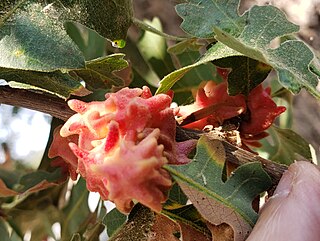
Besbicus heldae, formerly Cynips heldae, also known as the thorny gall wasp or thorn gall wasp, is an uncommon species of cynipid wasp that induces bud galls on Oregon oak and valley oak trees on the west coast of North America. Fresh gall are rose pink, measure 6–16 mm in diameter, and have a "mealy-granular" surface and possibly overlapping, disorderly looking "spikes". Galls are detachable and turn brown as they age. This gall superficially resembles the galls induced by Burnettweldia corallina or Cynips quercusechinus.

Diplolepis californica, formerly Rhodites californicus, also known as the leafy bract gall wasp, is a species of cynipid wasp that induces galls on wild roses on the Pacific coast of North America. D. californica induces club-shaped bud galls that naturalist Richard A. Russo describes as "distinguished from all others by the flat, leafy lobes that emanate from the main gall body and look like aborted leaflets". Each gall contains multiple larval chambers. One of host plants of the leafy bract gall wasp is Rosa californica.
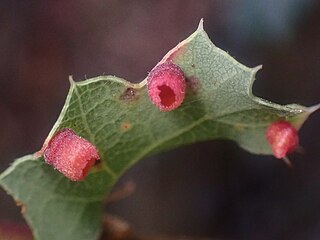
Phylloteras cupella, formerly Trigonaspis cupella, also known as the urn gall wasp or the banded urn gall wasp, is a species of cynipid wasp that induces leaf galls on a number of oak species in western North America. Host species include Arizona white, blue, Engelmann, gray, leather, netleaf, scrub, and shrub oaks. In the United States, galls induced by this species of wasp have been documented in California, Arizona, and New Mexico. This wasp is most likely also in Mexico and Canada.

Diplolepis bicolor, also known as the spiny bud gall wasp, is a species of cynipid wasp that induces bud galls on wild roses. This gall wasp is found throughout North America. The galls measure 10 to 12 mm in diameter and have a superficial resemblance to the leaf galls induced by Diplolepis polita.
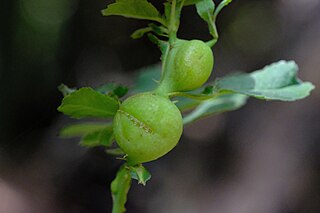
Diplolepis nodulosa, also known as the rose-stem gall wasp, is a species of cynipid wasp that induces bud galls on wild roses in North America. This galls induced by this species have a number of inquilines and parasitoids. D. nodulosa is assigned to a clade of Nearctic stem gallers within Diplolepis along with Diplolepis californica, Diplolepis oregonesis, Diplolepis spinosa, and Diplolepis triforma.

Diplolepis bassetti, also known as the mossy rose gall wasp, is a species of cynipid wasp that induces bud galls on wild roses in North America. Hosts include interior rose, Nootka rose, and pine rose.

Diplolepididae is a family of small gall-inducing wasps. Until recently these wasps were included in the gall wasp family (Cynipidae) but were moved to their own family based on genetic and morphological features. It contains two subfamilies: Diplolepidinae and Pediaspidinae.















